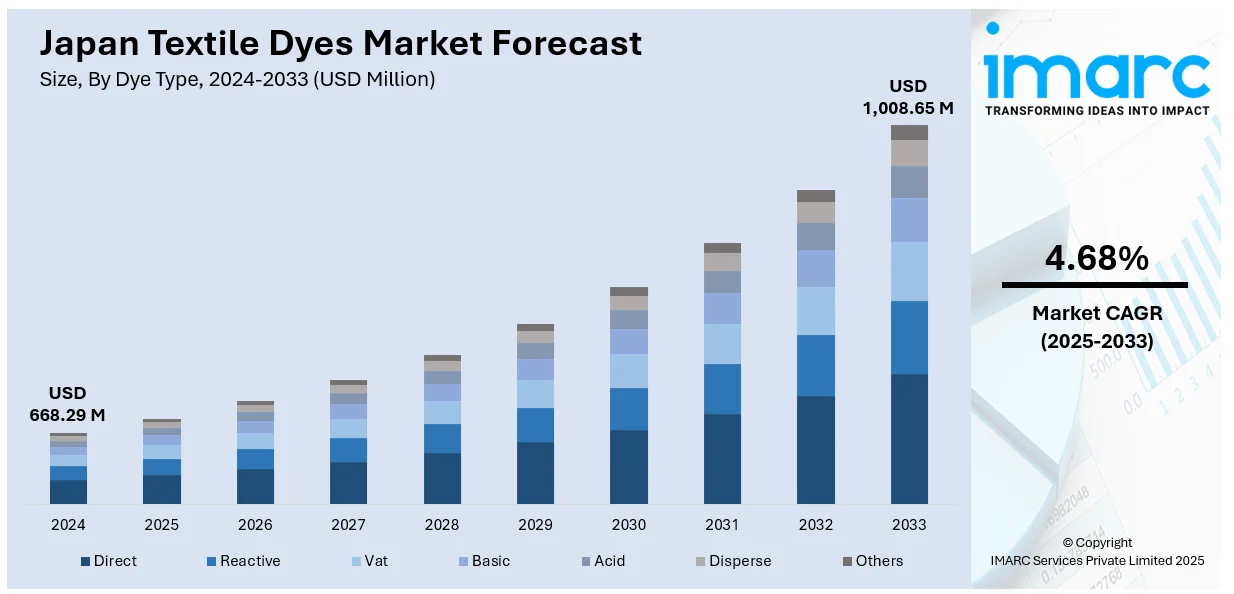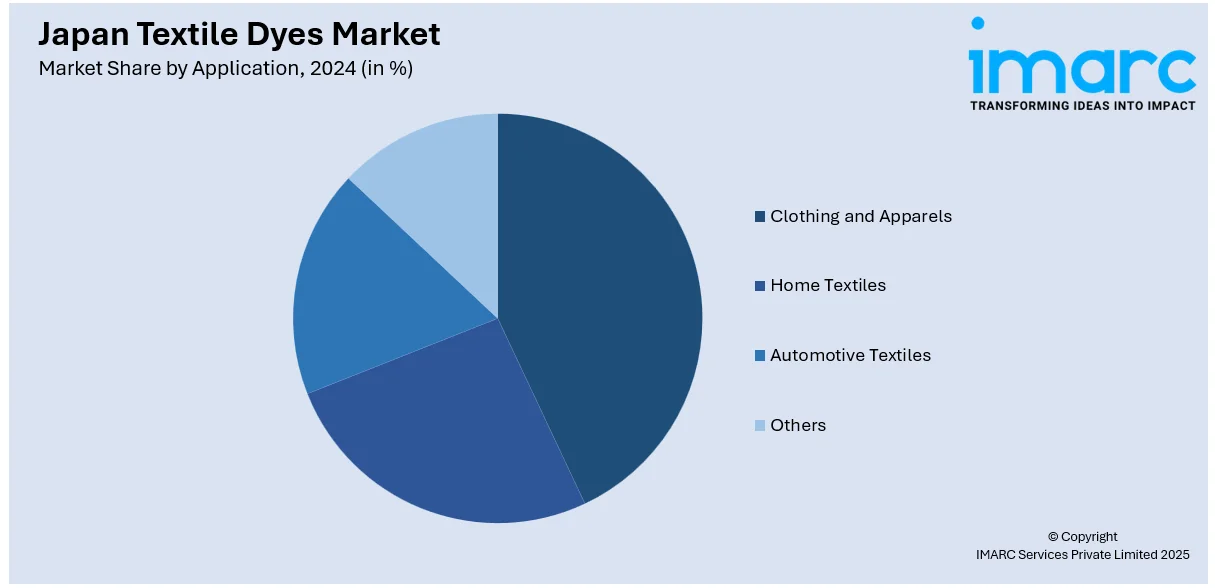
Japan Textile Dyes Market Size, Share, Trends and Forecast by Dye Type, Fiber Type, Application, and Region, 2025-2033
Japan Textile Dyes Market Overview:
The Japan textile dyes market size reached USD 668.29 Million in 2024. Looking forward, IMARC Group expects the market to reach USD 1,008.65 Million by 2033, exhibiting a growth rate (CAGR) of 4.68% during 2025-2033. Strong demand from the domestic fashion and apparel sector, increasing adoption of eco-friendly and waterless dyeing technologies, and growth in digital textile printing for customized designs are stimulating the market growth. Apart from this, use of natural dyes such as indigo in niche segments, innovation in bio-based dye formulations, investment in smart manufacturing and automation, growing popularity of sustainable fashion among youth, and collaborations between textile manufacturers and research institutes to develop advanced dyeing solutions are creative lucrative opportunities for the Japan textile dyes market share.
|
Report Attribute
|
Key Statistics
|
|---|---|
|
Base Year
|
2024 |
|
Forecast Years
|
2025-2033
|
|
Historical Years
|
2019-2024
|
| Market Size in 2024 | USD 668.29 Million |
| Market Forecast in 2033 | USD 1,008.65 Million |
| Market Growth Rate 2025-2033 | 4.68% |
Japan Textile Dyes Market Trends:
Demand from Japan’s Fashion and Apparel Sector
Japan’s fashion industry plays a major role in shaping the country’s textile dyes market. From high-end fashion houses in Tokyo to small designer labels, there is a steady demand for quality and innovation in textile coloring. Japanese consumers prefer well-crafted, stylish clothing, which encourages manufacturers to use diverse dyes that ensure strong colorfastness, soft textures, and premium finishes. The apparel market in Japan is also being influenced by the rise of fast fashion, custom clothing, and high-tech fabrics. As a result, dye makers are focusing on producing dyes that can meet varied performance needs, like resistance to fading or suitability for complex fabric blends. Additionally, many Japanese fashion brands are exporting to other countries, especially in Southeast Asia, increasing overseas demand for Japanese-dyed fabrics, further driving the Japan textile dyes market growth.

Innovation in Eco-Friendly Dyeing Technologies
The Japan textile dye industry is increasingly adopting sustainable technologies to meet growing environmental expectations. Traditional dyeing methods are being modernized, and companies are investing in processes that use less water, energy, and harmful chemicals. For example, waterless dyeing machines, originally developed abroad, are now being trialed by Japanese manufacturers to cut down on water usage. Bio-based dyes derived from plant and microbial sources are also gaining traction. These options reduce the impact of dye runoff on ecosystems and support Japan’s wider commitment to low-carbon manufacturing. Japan’s deep-rooted appreciation for natural materials is driving the revival of traditional indigo dyeing, particularly in Tokushima Prefecture, where artisans use sukumo (fermented indigo leaves) to create vivid blue hues with minimal chemicals. This aligns with Japan’s goal to integrate cultural heritage with modern sustainability standards. Despite the dominance of synthetic dyes, natural and cleaner alternatives are drawing attention due to regulatory pressure and consumer interest in sustainable fashion.
Growth of Digital Textile Printing
Digital textile printing is gaining popularity in Japan as fashion trends shift toward personalization, limited-edition runs, and fast turnaround times. Unlike traditional screen printing, digital methods allow for intricate, multi-color designs to be printed directly onto fabrics with fewer setup costs and shorter lead times. This is ideal for Japan’s fast-moving fashion brands that cater to niche markets or seasonal styles. The growing demand for printed textiles that are customized and environmentally efficient has encouraged wider adoption of reactive and disperse dyes compatible with digital inkjet systems. These dyes produce vibrant colors and work well on materials like cotton, polyester, and blends. Additionally, digital printing supports sustainability by minimizing water waste and fabric wastage compared to conventional methods. Japanese companies are also developing and exporting advanced printing machines and dye solutions, showing global leadership in this space. This trend is expected to strengthen as brands seek more flexible and eco-conscious printing solutions in line with consumer expectations.
Japan Textile Dyes Market Segmentation:
IMARC Group provides an analysis of the key trends in each segment of the market, along with forecasts at the country and regional levels for 2025-2033. Our report has categorized the market based on dye type, fiber type, and application.
Dye Type Insights:
- Direct
- Reactive
- Vat
- Basic
- Acid
- Disperse
- Others
The report has provided a detailed breakup and analysis of the market based on the dye type. This includes direct, reactive, vat, basic, acid, disperse, and others.
Fiber Type Insights:
- Wool
- Nylon
- Cotton
- Viscose
- Polyester
- Others
A detailed breakup and analysis of the market based on the fiber type have also been provided in the report. This includes wool, nylon, cotton, viscose, polyester, and others.
Application Insights:

- Clothing and Apparels
- Home Textiles
- Automotive Textiles
- Others
The report has provided a detailed breakup and analysis of the market based on the application. This includes clothing and apparels, home textiles, automotive textiles, and others.
Regional Insights:
- Kanto Region
- Kansai/Kinki Region
- Central/Chubu Region
- Kyushu-Okinawa Region
- Tohoku Region
- Chugoku Region
- Hokkaido Region
- Shikoku Region
The report has also provided a comprehensive analysis of all the major regional markets, which include Kanto Region, Kansai/Kinki Region, Central/Chubu Region, Kyushu-Okinawa Region, Tohoku Region, Chugoku Region, Hokkaido Region, and Shikoku Region.
Competitive Landscape:
The market research report has also provided a comprehensive analysis of the competitive landscape. Competitive analysis such as market structure, key player positioning, top winning strategies, competitive dashboard, and company evaluation quadrant has been covered in the report. Also, detailed profiles of all major companies have been provided.
Japan Textile Dyes Market News:
- In 2024, Kyocera introduced the FOREARTH inkjet textile printer, utilizing proprietary pigment ink to eliminate pre- and post-treatment processes. This system reduces water consumption in textile printing by 99%.
Japan Textile Dyes Market Report Coverage:
| Report Features | Details |
|---|---|
| Base Year of the Analysis | 2024 |
| Historical Period | 2019-2024 |
| Forecast Period | 2025-2033 |
| Units | Million USD |
| Scope of the Report |
Exploration of Historical Trends and Market Outlook, Industry Catalysts and Challenges, Segment-Wise Historical and Future Market Assessment:
|
| Dye Types Covered | Direct, Reactive, Vat, Basic, Acid, Disperse, Others |
| Fiber Types Covered | Wool, Nylon, Cotton, Viscose, Polyester, Others |
| Applications Covered | Clothing and Apparels, Home Textiles, Automotive Textiles, Others |
| Regions Covered | Kanto Region, Kansai/Kinki Region, Central/Chubu Region, Kyushu-Okinawa Region, Tohoku Region, Chugoku Region, Hokkaido Region, Shikoku Region |
| Customization Scope | 10% Free Customization |
| Post-Sale Analyst Support | 10-12 Weeks |
| Delivery Format | PDF and Excel through Email (We can also provide the editable version of the report in PPT/Word format on special request) |
Key Questions Answered in This Report:
- How has the Japan textile dyes market performed so far and how will it perform in the coming years?
- What is the breakup of the Japan textile dyes market on the basis of dye type?
- What is the breakup of the Japan textile dyes market on the basis of fiber type?
- What is the breakup of the Japan textile dyes market on the basis of application?
- What is the breakup of the Japan textile dyes market on the basis of region?
- What are the various stages in the value chain of the Japan textile dyes market?
- What are the key driving factors and challenges in the Japan textile dyes market?
- What is the structure of the Japan textile dyes market and who are the key players?
- What is the degree of competition in the Japan textile dyes market?
Key Benefits for Stakeholders:
- IMARC’s industry report offers a comprehensive quantitative analysis of various market segments, historical and current market trends, market forecasts, and dynamics of the Japan textile dyes market from 2019-2033.
- The research report provides the latest information on the market drivers, challenges, and opportunities in the Japan textile dyes market.
- Porter's five forces analysis assist stakeholders in assessing the impact of new entrants, competitive rivalry, supplier power, buyer power, and the threat of substitution. It helps stakeholders to analyze the level of competition within the Japan textile dyes industry and its attractiveness.
- Competitive landscape allows stakeholders to understand their competitive environment and provides an insight into the current positions of key players in the market.
Need more help?
- Speak to our experienced analysts for insights on the current market scenarios.
- Include additional segments and countries to customize the report as per your requirement.
- Gain an unparalleled competitive advantage in your domain by understanding how to utilize the report and positively impacting your operations and revenue.
- For further assistance, please connect with our analysts.
 Request Customization
Request Customization
 Speak to an Analyst
Speak to an Analyst
 Request Brochure
Request Brochure
 Inquire Before Buying
Inquire Before Buying




.webp)




.webp)












